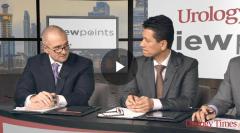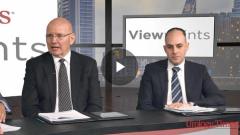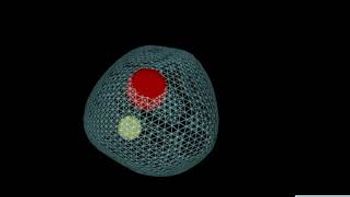
The Importance of Treating nmCRPC
Episodes in this series

[Transcript]
Raoul Concepcion, MD, FACS: Jahan, what if I have the patient with a PSA [prostate-specific antigen] doubling time of 12 or 14 months? How does that affect your decision making, understanding that we kind of know where these patients are going? Does it really fit the criteria that Gordon Brown just outlined? How do you look at that patient?
Jahan Aghalar, MD: You have to look at the individual patient and also consider what potential risk they may have and from the actual treatment itself. Apalutamide did show a significant risk of fall and fracture. If you are dealing here with an older patient walking in with a cane into your examination room, do we really need to put him on such a drug? First, he doesn’t fall within the trial eligibility criteria. Second, we’re not so sure whether there’s an overall survival benefit. There is a metastasis-free survival benefit, which I think is a clinically meaningful end point, but at the same time, if we’re putting that risk of having a fall and a potential fracture, have we done him a good service?
On the other hand, if we’re dealing with a younger patient in their 50s, with no major comorbidities, we feel pretty confident that his bone health is fine; he may have had a normal bone density recently. I think it would be worthwhile to introduce 1 of these agents for that meaningful end point, which as I mentioned would be metastasis-free survival.
Raoul Concepcion, MD, FACS: All right. Jorge.
Jorge Garcia, MD: I’m a bit more pragmatic about that. Maybe it’s the surgeon in me, who would tell me that if you look at the concept of M0 CRPC [castration-resistant prostate cancer], it’s something we have induced as a group, right? As you mentioned in an earlier segment, Gordon, someone who has undergone local definitive therapy, radiation, surgery, and the combination in a sequential manner, who has progressed biochemically and had a rising PSA or biochemical recurrence, you make the decision to start that patient on androgen deprivation therapy [ADT]. Whether you did it intermittently or continuously, what happened is you render that patient castrated. You castrated that man, and then basically a patient became castration resistant. More than likely, because the natural history is driven by PSA first for most patients, you will find that patient has M0 CRPC.
It would be very hard, in my personal opinion. I’m not saying that it’s right, but to tell a patient, “I started you on ADT when you had biochemical recurrence, after surgery or radiation therapy. And now that your PSA is rising again, despite you being castrated, I’m going to wait, and I’m going to wait for your PSA to really move faster.”
This is a pretty foreign concept to me, so I would argue that if I started you on ADT, because I felt the need for you to have ADT because of biochemical recurrence, it would be difficult for me not to put you on a therapy where you have a doubling time of 15 months, 10 months, 13 months, and so forth. I think it’s very important. You raise a great point. These agents don’t come without a financial toxicity, and without physical toxicity, diarrhea, and the adverse effects from all these agents.
It is a class effect, in my opinion. Right now, I also remind ourselves that if you look at the makeup of these drugs, 2 of 3 drugs did allow patients with up to 2-cm lymph nodes. Traditionally, if I were to get a patient with a CT [computed tomography] with a couple of 1½- or 2-cm lymph nodes, although that patient may have met the criteria for the trial, for me that patient really has metastatic disease, right?
But you know, a lot of people think that we think of our prostate cancer patients in a very linear manner, which means, what is your doubling time? Did you have it scanned, yes or no? And I think most of us will pay attention to how long it took you to fail. How long were you on ADT? What was your Gleason score from diagnosis? What was your primary treatment? There’s a series of features of your disease that would allow you and I, clinically speaking, to say, “You know what? Even if your doubling time is not moving that fast, I think it’s important for you to get on therapy.”
Lastly, as we have said before, this is the first time the regulatory agencies allow a different primary end point for registration outside survival. And we have come to a realization that delaying clinical symptomatic disease, delaying radiographic progression or time to death from any cause, may be more meaningful to our prostate cancer patients than whether you truly lead to survival improvement.
Matt Smith at ESMO [the European Society for Medical Oncology Congress] presented the earlier analysis for survival for TITAN, for the SPARTAN data. And that data would suggest that it’s very close to meeting survival improvement, right? If we finalized those trials and we have a survival improvement that we can see and demonstrate statistically, the community will adopt these agents far more with open arms than now.
Raoul Concepcion, MD, FACS: Jorge, great, great points. Great comments. Gordon, as you mentioned, 5 years ago, for all of us who were on clinical trials, if we had identified this nonmetastatic M0 patient based [on] the historic Matthew Smith data, within 2 years 50% of these patients would have ended up with metastatic disease radiographically. It was very frustrating if you did not have an M0 trial to just sit here and say, “OK, I know what you have, but I got nothing.”
Jorge Garcia, MD: Right.
Raoul Concepcion, MD, FACS: You can probably get away writing on compendia, but the grim reality was, that’s what we were stuck with. Paul, I’m going to direct this question to you, because I’m convinced that the urology community is probably the guiltiest. We have 3 agents with great trials, have benefit. But we still have a significant number of-and I’m just going to pin it on the urologists who are using first-generation anti-androgen bicalutamide. Is there a role of bicalutamide in this castration-resistant prostate cancer patient, nonmetastatic?
Paul Sieber, MD: If he suffers from severe PSA anxiety, maybe. But that’s about it. I think that’s what I would have argued even earlier when Jahan was talking about the guy who’s got a PSA doubling time at 14 months, 16 months saying, “Well, I’m going to about it”-no data, no data. We’re treating a number. The trialists I know from prostate cancer were in group 1 and then 2 and 3. PSA is nice, but there’s more that comes into play. I think I want to have hard facts. I don’t care what the package insert says; the study was less than 10 months. I stick to 10 months. I’m never going to fall back to a bicalutamide, because you have no data. We’re just playing with numbers, as we learned a long time ago. When you play with everyone getting superagonists to check a PSA recurrence, it’s the wrong thing. You’re hurting people.
I think you’re making a mistake, and I think you want to carefully individualize who gets treated even in this category as we talk about adverse effects, because we’re learning their adverse effects. Two of 3 drugs now carry cardiac warnings.
If I had a guy who’s had 2 angioplasties and the stents in the last 5 years, do I want to put him on a drug he’s going to be on for 3 years? He’s going to have to come off drug. I’m looking at adverse effects a lot more judiciously now. It’s in-depth history. I take a bone history now. I take a genetic history now. I take a neurological history. If the guy had a severe conclusion playing football, I worry about that guy. Maybe he’s the right guy to say, “OK.” But even now, I’ve got other agents that have other adverse-effect profile patterns for whom maybe not crossing the blood-brain barrier with darolutamide is going to make a difference. They did treat people with seizures. You have to think about a lot of factors when you’re saying who gets treated. But certainly, throwing a drug like Casodex-which has no data, just PSA response-is probably the wrong thing to do in 2019.
Raoul Concepcion, MD, FACS: I think all of us would agree that it’s up to us to treat the disease and not treat a number. We have to treat the disease, and you have to look at it in its totality-what’s happening at the molecular level. As you said, Paul, understand the data in terms of risk-reduction benefits and those types of things.
Panelists:
- Raoul Concepcion, MD, FACS, Vanderbilt University School of Medicine, Nashville, Tennessee
- Jahan Aghalar, MD, Board-certified Hematologist and Oncologist, New York, New York
- Gordon Brown, MD, Rowan University School of Osteopathic Medicine, Glassboro, New Jersey
- Jorge Garcia, MD, Cleveland Clinic, Cleveland, Ohio; Jonathan Henderson, MD, Regional Urologist, Shreveport, Louisiana
- Paul Sieber, MD, Penn Medicine Lancaster General Hospital, WellSpan Ephrata Community Hospital, Lancaster, Pennsylvania
Newsletter
Stay current with the latest urology news and practice-changing insights — sign up now for the essential updates every urologist needs.
































